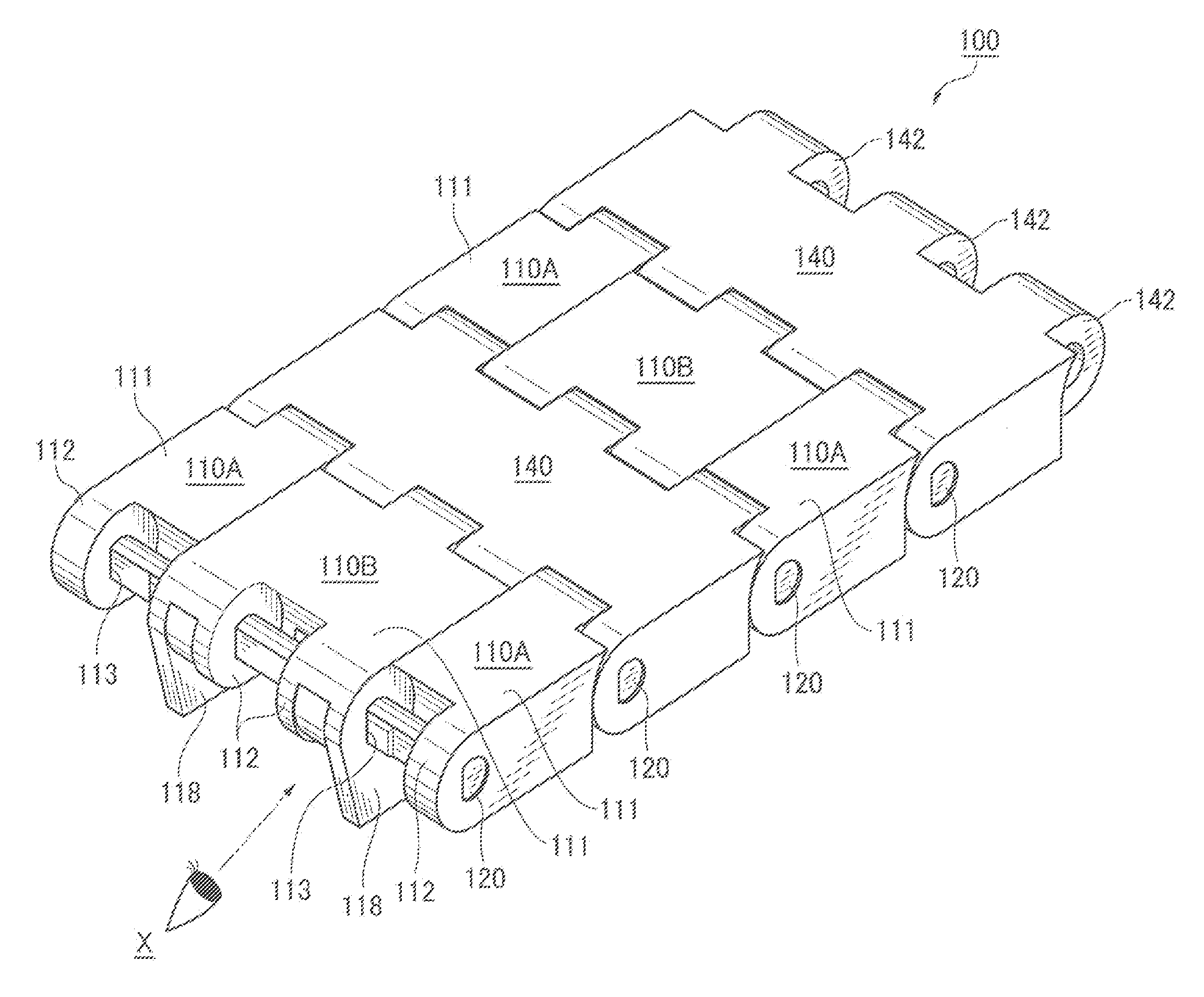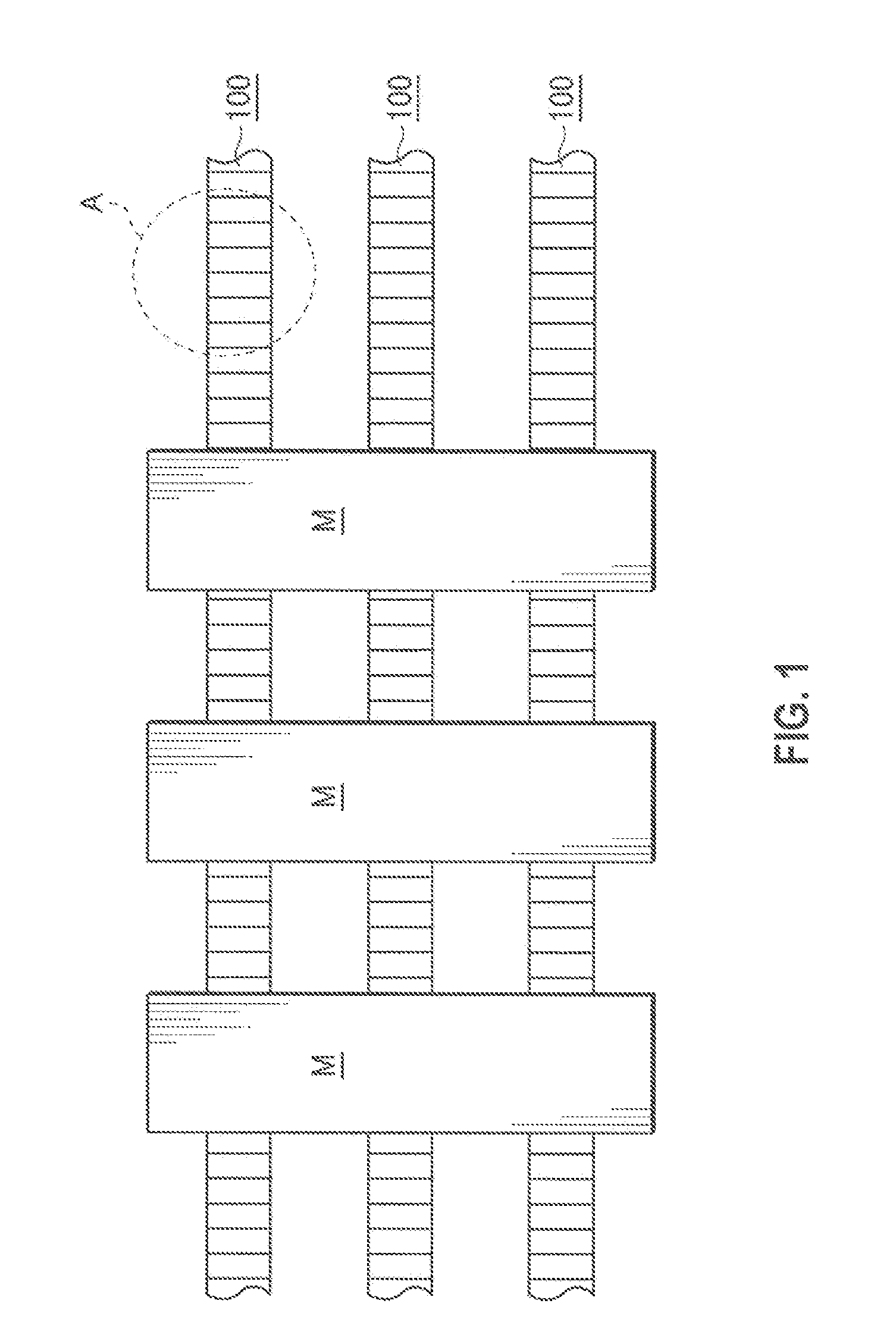Conveyor chain
a conveyor chain and conveyor technology, applied in conveyor parts, transportation and packaging, rollers, etc., can solve the problems of prior art magnet-equipped chains, inability to steadily convey articles m, other difficulties, etc., to prevent the magnet piece from escaping, prevent the magnet piece from being damaged, and reliably fix the magnet piece
- Summary
- Abstract
- Description
- Claims
- Application Information
AI Technical Summary
Benefits of technology
Problems solved by technology
Method used
Image
Examples
first embodiment
[0041]A first embodiment of a conveyor chain of the invention will be explained below with reference to the drawings.
[0042]Here, FIG. 1 is a schematic diagram showing a mode of use of a conveyor chain of a first embodiment of the invention, FIG. 2 is an enlarged view of a part A of the conveyor chain of the first embodiment shown in FIG. 1, FIG. 3 is an assembly exploded view of the conveyor chain of the first embodiment of the invention, FIG. 4 is a perspective view of the conveyor chain seen from a view point X on the back of the chain shown in FIG. 2, FIG. 5 is a side view seen from a magnet piece inserting side of a magnetism generating link module shown in FIG. 2, FIG. 6 is a front view of the conveyor chain shown in FIG. 2, FIG. 7 is an operational view of the conveyor chain shown in FIG. 1 in conveying articles on a slope, FIG. 8 is an assembly exploded view of a conveyor chain of a second embodiment of the invention, FIG. 9 is an assembly exploded view of a conveyor chain of...
second embodiment
[0072]A conveyor chain 200 of a second embodiment of the invention will be explained next with reference to FIG. 8.
[0073]Similarly to the conveyor chain 100 shown in FIG. 1, the conveyor chains 200 as shown in FIG. 8 are also arrayed respectively in parallel in the line width direction of the conveyor line and convey articles M which are long in the conveying line width direction upward on a slope.
[0074]That is, as shown in FIG. 8, the conveyor chain 200 of the second embodiment of the invention comprises a plurality of synthetic resin link modules 210 each having a loading portion 211 for loading the articles M and hinge portions 212 projecting from the front and rear parts of the loading portion 211. The conveyor chain is constructed by linking the large number of synthetic resin link modules in the chain longitudinal direction in a predetermined array pattern by inserting link pins 220 through pin inserting holes 213 formed through the hinge portions 212 of these synthetic resin ...
third embodiment
[0080]a conveyor chain 300 of a third embodiment of the invention will be explained next with reference to FIG. 9.
[0081]Similarly to the conveyor chain 100 shown in FIG. 1, the conveyor chains 300 as shown in FIG. 9 are also arrayed respectively in parallel in the line width direction of the conveyor line and convey specifically long articles M which are long in the conveying line width direction upward on a slope.
[0082]That is, as shown in FIG. 9, the conveyor chain 300 of the third embodiment of the invention provided respectively in the conveyor line comprises a plurality of synthetic resin link modules 310 each having a loading portion 311 for loading the articles M and hinge portions 312 projecting from the front and rear parts of the loading portion 311. The conveyor chain is constructed by linking the large number of synthetic resin link modules in the chain longitudinal direction in a predetermined array pattern by inserting link pins 320 through pin inserting holes 313 form...
PUM
 Login to View More
Login to View More Abstract
Description
Claims
Application Information
 Login to View More
Login to View More - R&D
- Intellectual Property
- Life Sciences
- Materials
- Tech Scout
- Unparalleled Data Quality
- Higher Quality Content
- 60% Fewer Hallucinations
Browse by: Latest US Patents, China's latest patents, Technical Efficacy Thesaurus, Application Domain, Technology Topic, Popular Technical Reports.
© 2025 PatSnap. All rights reserved.Legal|Privacy policy|Modern Slavery Act Transparency Statement|Sitemap|About US| Contact US: help@patsnap.com



